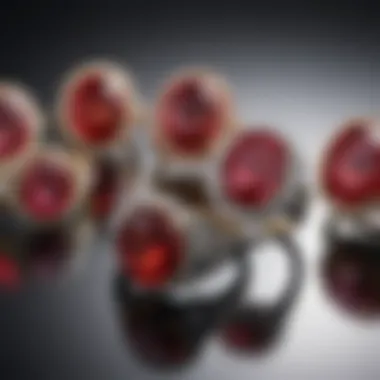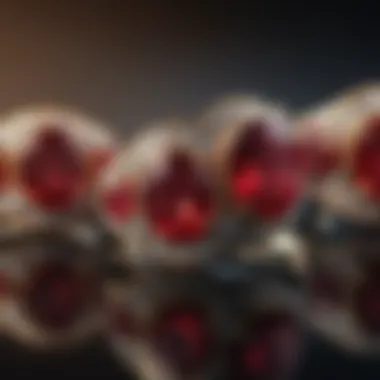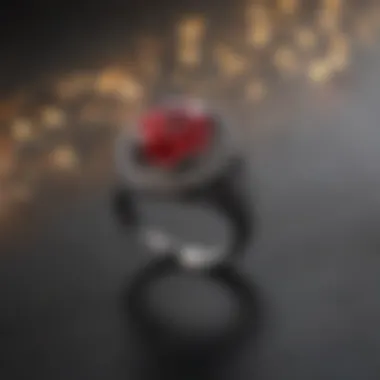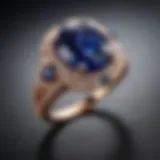Understanding Ruby Ring Costs: Key Factors & Trends


Intro
The jewelery market is vast and intricate, with ruby rings standing out for their unique allure. They are often seen as symbols of luxury and elegance. Understanding the cost of these ruby rings involves delving into various elements. From the characteristics of the ruby itself to market dynamics, this article will unpack the essential factors impacting pricing.
Overview of Gemstones and Minerals
History of Gemstone and Mineral Use
Gemstones have been cherished for thousands of years. Ancient civilizations used them not only for decoration but also for believed spiritual and healing properties. Rubies, in particular, have a storied past. Their rich red hues made them symbols of passion and protection. Ancient cultures, especially in Asia, considered rubies more valuable than diamonds.
Significance in Culture and Society
The cultural significance of rubies extends beyond mere aesthetics. Throughout history, rubies were associated with nobility and power. It was common for kings and queens to adorn themselves with ruby jewelry. In some cultures, rubies are believed to bring good fortune and health. Their connection to strong emotions, like love and courage, makes them a popular choice for engagement and anniversary rings.
Gemstone Formation and Properties
Formation Process of Gemstones
Rubies are formed from corundum, a mineral consisting primarily of aluminum oxide. The presence of chromium gives rubies their red color. These gemstones typically form deep within the Earth under high-pressure and high-temperature conditions. The geological processes involved include both metamorphic and igneous formations.
Properties that Define Gemstones
Rubies are prized for their hardness, a property rated at 9 on the Mohs scale. This makes them durable enough for everyday wear. Clarity, color saturation, and cut are also critical factors. The quality of a ruby can significantly influence its price.
Classification based on Color, Hardness, and Luster
Gemstones can be categorized by several properties. Color variations in rubies range from vivid red to pinkish shades. Hardness is a defining factor as discussed, and their luster can vary from vitreous to resinous, affecting their overall appeal.
Types of Gemstones
Precious vs. Semi-Precious Gemstones
In the jewelry world, rubies fall under the category of precious gemstones, along with diamonds, sapphires, and emeralds. This classification often leads to higher values. Semi-precious stones, which include varieties like amethyst and topaz, generally fetch lower market prices.
Common Gemstone Varieties
Apart from rubies, there are well-known gemstone varieties. These include sapphires, emeralds, and diamonds. Each gem has its own unique characteristics and appeal, which can influence the buyer's choices.
Exotic and Rare Gemstones
Aside from common varieties, the market also offers exotic options. Some collectors seek rare gemstones that offer unique colors or characteristics, such as Alexandrite or Paraiba Tourmaline. The rarity can significantly affect the pricing.
Identifying and Evaluating Gemstones
Factors Affecting Gemstone Value
Several factors contribute to the value of rubies. Key elements include carat weight, clarity, color, and origin. For instance, Burmese rubies are often more sought after due to their quality. Provenance can play an essential role in establishing a gem's worth.
Techniques for Gemstone Identification
Professionals use various methods for gemstone identification. These methods include visual inspection, microscopy, and spectroscopy. Evaluation often requires specialized knowledge and equipment.
Assessing Gemstone Quality
To assess the quality of a ruby ring, one should consider the four Cs - color, clarity, cut, and carat weight. Each component interacts to provide a comprehensive evaluation of the gemstone’s value.
Caring for Gemstones


Cleaning and Storing Gemstones Properly
To maintain the condition of a ruby ring, proper cleaning is critical. Mild soap and warm water work well for cleaning. Avoid ultrasonic cleaners which could damage the stone. Storing in a soft pouch can prevent scratches.
Avoiding Common Mistakes in Gemstone Care
Common mistakes include exposing rubies to harsh chemicals and extreme temperature changes. Such elements can damage the stone's quality over time.
Preservation Tips for Specific Gem Types
With rubies, minimizing exposure to high heat is important. Keeping them away from perfumes or cosmetics can also protect their integrity.
Understanding the nuances of ruby rings enhances the purchasing experience for both collectors and casual buyers.
Understanding Ruby as a Gemstone
Understanding ruby as a gemstone is crucial when evaluating the cost of ruby rings. Rubies are not only beautiful but also possess distinct qualities that contribute to their value. Their vibrant colors and rarity make them popular in the jewelry market. However, to appreciate a ruby's worth fully, one must examine various aspects that define it as a gemstone.
Defining Ruby
Ruby is a variety of the mineral corundum, which is composed of aluminum oxide. The deep red color of rubies comes primarily from the presence of chromium. In its pure form, corundum is colorless, but impurities lead to the formation of colored varieties, particularly sapphires in shades other than red. Rubies are valued for their rich hue, which can range from pinkish-red to blood-red. This color intensity significantly affects their price. High-quality rubies can fetch prices that rival, or even surpass, those of diamonds.
Historical Significance of Ruby
Rubies have a long-standing historical significance across cultures. They have been associated with power and royalty, often worn by kings and queens. In ancient times, they were believed to possess protective qualities, warding off evil and bringing good fortune. Some cultures even regarded rubies as sacred stones, symbols of love and passion. The historical context of rubies adds depth to their value, reflecting human desires and historical narratives, making them not just gems but stories etched in time.
Common Uses in Jewelry
In jewelry, rubies are commonly set in rings, necklaces, and earrings. They are particularly favored in engagement rings, offering a bold alternative to traditional diamonds. The durability of rubies, rated 9 on the Mohs hardness scale, makes them suitable for everyday wear. Designers often utilize rubies in various styles, from classic solitaires to intricate vintage designs. Beyond aesthetic appeal, rubies also serve as a symbolic choice representing love and passion, leading to their frequent inclusion in significant jewelry pieces.
"Rubies symbolize love and passion, making them a popular choice for engagement rings."
In summary, understanding ruby as a gemstone is a comprehensive endeavor. It involves studying its definition, historical role, and applications in jewelry. Each aspect enriches the narrative of rubies, illustrating why they hold a compelling allure in the fine jewelry market.
Factors Determining the Price of Ruby Rings
When discussing ruby rings, several factors critically impact their pricing. Understanding these elements offers valuable insights for potential buyers and collectors. The interplay between quality, origin, and current market trends governs the overall cost of ruby rings. An appreciation of these factors is crucial for discerning consumers who wish to make informed purchasing decisions.
Quality of Ruby: The Four Cs
Color
Color is a primary determinant of a ruby's value. The most sought-after shade is a vibrant red, often referred to as "pigeon blood" red. This particular hue enhances desirability, which can lead to higher prices. A ruby's color can considerably impact its overall appeal. Rubies that display an even distribution of color, without zoning or color variances, tend to attract collectors and investors alike. However, stones with overly dark or pale hues may sell at lower price points.
Clarity
Clarity is another critical aspect to consider when evaluating rubies. While some inclusions can add character to a stone, fewer inclusions generally mean a higher quality ruby. Stones that are eye-clean, meaning no inclusions visible to the naked eye, tend to command higher prices. Clarity influences light return and sparkle. A ruby with clearer clarity exhibits more brilliance, thereby providing more visual appeal to buyers.
Cut
The cut of a ruby influences how light interacts with the stone, significantly affecting its overall look. An expertly cut ruby reflects and refracts light more effectively, enhancing its vibrancy. Conversely, a poorly cut ruby can appear dull and lifeless, leading to lower valuations. The shape and symmetry of the cut also play roles, as specific cuts may be more desirable in the market.
Carat
Carat weight is a straightforward measure, yet it inherently affects the price. Larger rubies are rarer and tend to be more expensive. However, the value doesn't increase linearly with carat size; instead, the jump in price can be exponential as size increases. Smaller stones can have excellent quality and high prices, but they are generally more accessible for collectors.
Origin of the Ruby
Burma Rubies


Burma rubies, particularly those from the Mogok Valley, are renowned for their rich color and quality. The deep red color often fetches premium prices. These rubies are considered some of the best globally due to their rarity and desirable attributes. Collectors value Burma rubies for both their beauty and historical significance. However, the geopolitical issues surrounding this region can impact their availability and pricing.
Thai Rubies
Thai rubies are recognized for their striking reddish-pink shades. While these rubies are of good quality, they are often priced lower than their Burmese counterparts due to higher production and availability. Thai rubies tend to be more commercial, and this can put downward pressure on their prices in the market. Nonetheless, they offer a balance of quality and affordability, attracting many buyers.
Tanzania Rubies
Tanzania is emerging as a significant source of rubies, with the Losses and Songea regions producing quality stones. Tanzanian rubies often exhibit a darker hue, which some collectors find appealing. While not as valuable as Burmese rubies, they offer a great option for budget-conscious consumers. However, the market for Tanzanian rubies is evolving, and they may gain prominence due to their unique features and growing popularity.
Market Demand Trends
Market demand trends play a significant role in the pricing of ruby rings. Current preferences for gemstone styles, consumer interest in colored gemstones, and economic factors influence what buyers are willing to pay. As awareness and appreciation for ruby rings grow, so does competition among buyers, further driving prices higher. Understanding these trends is essential for anyone looking to invest in or purchase ruby rings.
Comparative Analysis with Other Gemstones
In the realm of fine jewelry, understanding how ruby rings compare to other gemstones is pivotal. This analysis not only sheds light on the pricing dynamics but also helps consumers appreciate the unique characteristics of rubies relative to their counterparts. Knowing where rubies stand in relation to alternatives such as sapphires, diamonds, and emeralds can inform purchasing decisions and investment strategies. Given the subjective nature of gemstone valuation, a comparative viewpoint can enhance comprehension of market trends and price structures. It spots the nuances that might affect desirability, rarity, and overall value.
Ruby vs. Sapphire: Price Comparison
Rubies and sapphires are both corundum varieties, differing primarily in their colors. Rubies are renowned for their vibrant reds, while sapphires typically come in a variety of blue hues. Price comparisons reveal significant contrasts. High-quality rubies tend to command higher prices than equally high-rated sapphires. Factors contribute to this disparity:
- Scarcity: Rubies are generally more rare than sapphires. The laws of supply and demand naturally elevate ruby prices.
- Color Quality: The ideal color for rubies is a deep, saturated red, which is less common when compared to the vast range of sapphires available.
- Market Trends: Current preferences can affect value. For instance, as ruby popularity grows, so does the willingness of buyers to invest.
Given these aspects, it’s essential to evaluate individual gemstones closely, rather than depend solely on general comparisons.
Ruby vs. Diamond: Cost Metrics
When assessing the cost metrics between rubies and diamonds, a few distinct attributes emerge. Diamonds are often viewed as the standard for precious gemstones, primarily due to their enduring appeal and cultural significance. However, rubies often provide a more compelling investment:
- Quality Definition: Diamonds are graded with the Four Cs: carat, cut, color, and clarity. Rubies, while also evaluated similarly, place a stronger emphasis on vibrant color and clarity. This means that a slightly inferior ruby, in terms of clarity, could still possess a color that significantly boosts its overall value.
- Market Fluctuations: The diamond market has been known for artificial inflation due to monopolistic practices. Rubies, by contrast, often experience price enhancements driven by organic demand.
- Investment Outlook: Over time, fine rubies have shown better appreciation relative to diamonds, making them an attractive choice for collectors and investors alike.
Ruby vs. Emerald: Valuation Insights
Emeralds, while captivating, face different valuation challenges in comparison to rubies. Their lush green color is highly prized; nonetheless, certain qualities can impede their market price relative to rubies:
- Durability: Rubies are among the hardest gemstones, rated a 9 on the Mohs scale, making them more resistant to damage than emeralds, which are rated at 7.5 to 8. This durability makes rubies a wiser choice for everyday wear.
- Clarity Considerations: While fine emeralds are often more opaque and may contain inclusions, rubies with high clarity are more sought after, enhancing their overall market value.
- Cultural and Historical Significance: Both gemstones carry rich historical narratives. Nevertheless, rubies have been consistently associated with wealth and power throughout history, fostering a perception that can lead to higher valuations.
Each of these comparisons illustrates the complex economics surrounding rubies in their sphere among other gemstones. Understanding these relationships provides essential context for potential buyers, helping them navigate the sometimes murky waters of gemstone purchases.
Market Trends and Consumer Behavior
Understanding market trends and consumer behavior is crucial in evaluating the cost of ruby rings. These trends can provide valuable insight into how demand fluctuates over time, which directly impacts pricing and availability. Consumers need to comprehend how economic factors, preferences, and trends influence the market dynamics for rubies. Making informed choices becomes easier when one understands these trends, leading to enhanced satisfaction with their investment in ruby jewelry.
Emerging Markets for Ruby Rings
Emerging markets have recently attracted attention in the ruby ring sector. Countries like China and India are witnessing a significant increase in demand, driven by a growing middle class with disposable income. In these regions, rubies are not only viewed as luxury items but also as symbols of status and cultural significance. As a result, the increase in purchasing power in these nations influences global pricing trends.
Rubies sourced from regions like Burma have become particularly popular among consumers in these emerging markets. Unique attributes, such as the vivid color and high quality of these stones, drive their desirability. Additionally, the marketing strategies in these regions emphasize the emotional and traditional value of ruby jewelry.
Cultural Influences on Ruby Valuation
Cultural influences play a significant role in how rubies are valued across different societies. In some cultures, rubies symbolize love and passion, making them a popular choice for engagement rings. This prevailing sentiment impacts market demand and pricing. For instance, in India, rubies are considered auspicious and often associated with good fortune. Thus, their cultural significance elevates their perceived value.
Moreover, the way rubies are represented in cultural narratives can affect consumer behavior. Marketing campaigns that align with cultural beliefs can enhance consumer interest. For example, films and literature showcasing rubies as desirable treasures can create a buzz that affects ordering patterns and prices.
"Understanding the cultural significance of rubies allows consumers to appreciate their value beyond just the monetary aspect."


In summary, being aware of emerging markets and cultural influences enhances understanding of the pricing strategies for ruby rings. These factors inform consumer choices as they navigate purchasing decisions in a complex marketplace.
Purchasing Considerations for Ruby Rings
Understanding the purchase of ruby rings is essential for both novice buyers and seasoned collectors. The intricacy of the ruby's qualities, coupled with market trends, plays a crucial role in determining value. Buyer awareness of these elements can lead to informed decisions, ensuring that investments align with personal preferences and financial goals. Knowing the specifics can prevent pitfalls, especially given the notable price variance in different pieces.
Evaluating Retail Prices
When shopping for ruby rings, evaluating retail prices requires careful consideration. Multiple factors influence these prices, including the retail jeweler’s mark-up, the rarity of the stone, and the overall quality. It is important to research prices from various sources before committing to a purchase. Comparisons between different jewelers can reveal significant discrepancies in pricing.
One may gather information from online marketplaces, auction results, and physical stores. Factors to ponder include:
- Market Trends: Current trends can drive prices up or down. Awareness of these trends helps in understanding whether a ring is priced competitively.
- Seasonality: Certain times of the year may bring about discounts or premium mark-ups, especially around holidays.
- Stock Levels: If a particular design or type of ruby is in limited supply, expect higher prices. Conversely, if there is a surplus, prices may be lower.
It's also recommended to approach high-end retailers with caution. While prestige can assure quality, it can also inflate costs.
The Role of Certification
Certification is vital in enhancing trust in the purchase of ruby rings. A certified gemstone guarantees that the stone has undergone rigorous evaluation by a reputable organization. Understanding the significance of certification can lead to better investment choices.
Common certifications include those from institutions like the Gemological Institute of America (GIA) and the American Gemological Society (AGS). Key points regarding certification include:
- Authenticity: Certification affirms the gemstone's authenticity. Non-certified stones may potentially be misrepresented.
- Quality Confirmation: Certifications often outline the ruby's quality, including specifics about its color, clarity, cut, and carat weight. This allows buyers to understand the stone’s characteristics in detail.
- Resale Value: Certified stones typically have better resale value. Resellers often prefer certified rubies due to their established quality assurances.
In summary, purchasing a ruby ring requires a thoughtful approach, weighing factors such as retail pricing and certification. With informed decisions, buyers can confidently navigate the complexities of ruby rings in a way that aligns with their interests and investment strategies.
Future Insights on Ruby Pricing
Understanding the future pricing trends of ruby rings is crucial for anyone involved in the gemstone market. This section dives into anticipated shifts in ruby ring prices and the potential impact of sustainable practices. Evaluating future insights enables collectors, jewelers, and enthusiasts to make informed decisions and navigate a dynamic market.
Potential for Price Increase
Ruby rings have historically demonstrated a robustness in price appreciation, particularly in certain market conditions. As demand rises and sources become scarcer, one can expect prices to trend upward.
Factors contributing to this potential increase include:
- Rarity of High-Quality Rubies: Fine rubies, especially those with vivid colors and minimal inclusions, are increasingly rare. The decreasing availability of these stones will likely push prices higher.
- Growing Global Demand: There is a noticeable increase in interest for ruby rings, especially in emerging markets. Countries such as India and China are witnessing a surge in luxury goods consumption, including gemstones.
- Cultural Significance: Rubies are often associated with love and passion, making them popular choices in engagement rings and other significant jewelry pieces. This emotional value can further elevate demand.
As these factors converge, consumers should closely monitor the ruby market. Engaging with reputable dealers and staying informed on trends will be essential for making smart investments in ruby rings.
Impact of Sustainable Practices
The practice of sustainability has become more significant in the jewelry industry. As consumers grow more conscious of their purchasing habits, the emphasis on ethically sourced rubies is likely to influence market prices.
Consider the following points:
- Consumer Demand for Transparency: Buyers are increasingly looking for stones that are sourced responsibly. This shift means that rubies from sustainable mines may command higher prices due to their ethical appeal.
- Environmental Considerations: Mines that adhere to strict environmental practices may incur higher operational costs. These costs may be reflected in the prices of their gems, pushing consumers to pay a premium for sustainability.
- Certifications and Assurance: As the market develops, certifications that guarantee ethical sourcing will likely become more available, adding a layer of credibility and value to sustainably sourced rubies.
The integration of sustainable practices in the gemstone supply chain can lead not only to ethical advantages but can also enhance the market value of ruby rings over time.
As the market evolves, these sustainability trends will play a crucial role in determining the future landscape of ruby pricing. Consumers prioritizing ethically sourced gemstones will shape the conversation around value and investment in ruby jewelry.
Epilogue
Evaluating the cost of ruby rings involves multiple layers of complexity. Understanding the factors that influence their pricing is crucial for consumers aiming to invest wisely. Stakeholders must look beyond the surface; various elements play a part. These include the quality of the ruby, its origin, market demand, and how it compares to other gemstones.
The significance of these factors lies in their ability to inform purchasing decisions. When consumers comprehend the metrics that drive value, they can navigate the market more effectively. The knowledge gained helps to avoid pitfalls often present in luxury goods. Notably, this understanding is paramount in distinguishing between a genuine investment and an inflated price.
Final Thoughts on Value and Investment
Several considerations should remain top of mind:
- Intrinsic Value: Each ruby’s quality determines its worth. Factors such as color saturation, clarity, and cut cannot be overlooked.
- Market Fluctuations: Trends in consumer demand play an important role in pricing. Awareness of these trends can assist buyers in your timing.
- Long-term Considerations: Investing in rubies can yield significant returns if approached thoughtfully. Historical value retention encourages confidence in long-term investment strategies.
Thus, obtaining a ruby ring is not merely about ownership; it represents an entry point into a robust world of value, investment, and cultural significance. As the market evolves, staying informed helps ensure that consumers remain adept at making choices that align with their investment goals.







